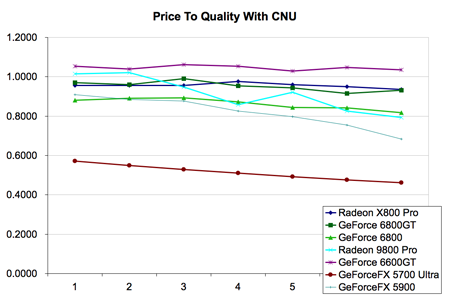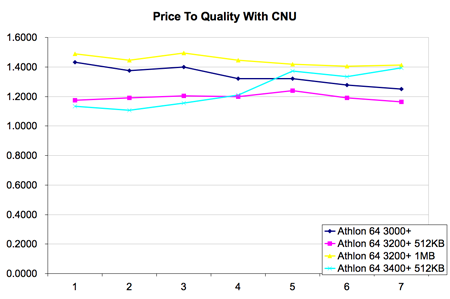Beating the System: The AnandTech Guide to Economic Upgrading
by Kristopher Kubicki & Jarred Walton on January 30, 2005 5:59 PM EST- Posted in
- Guides
A Simple Example
Now that we have the basics on what a graphical model looks like and how it functions, let us see if we can construct something similar for actual components. For this example, we are going to rewind into the past six months and base all of our devaluation assumptions on actual data pulled from our RealTime Price Engine. Suppose our hypothetical machine to upgrade looks like the following:Processor: Athlon 64 2800+ Socket 754This machine clearly looks GPU limited, but we won't let that stop us from choosing a whole subset of new components for our price set. Since we just did an article on it, the goal in this example will be to spend around $200 for a computer upgrade in order to maximize Half Life 2 performance. Once again, we need to add some padding on each end of the $200 budget so that we can have some leeway when we introduce Time into the model. Our list of products is as follows:
Memory: 512MB DDR-400
Video Card: ATI Radeon 9600 Pro
Motherboard: MSI nForce3 K8N Neo-FSR
Processor: All Socket 754 Processors better than an Athlon 64 2800+
Video Card: All AGP video cards better than a Radeon 9600 Pro
Let's plot as many of these components as possible on a graph denoting their price. We are slightly limited in our purchasing decision tree because we need to select components that fall within our designated price budget, but also components that are compatible with our hardware. This is a simple example, so we won't introduce components like memory, hard drives or motherboards for the time being. The prices were current prices as listed from the RealTime Price Engine. To keep our graphs neat, we separated video and graphics cards.
| Product | Price 6 Months Ago | Relative Quality | Product | Price 6 Months Ago | Relative Quality | |
| Radeon X800 Pro | $418.00 | 400.00% | Athlon 64 3000+ | $164.00 | 105.00% | |
| GeForce 6800GT | $412.00 | 400.00% | Athlon 64 3200+ 512KB | $230.00 | 108.00% | |
| GeForce 6800 | $295.00 | 260.00% | Athlon 64 3200+ 1MB | $205.00 | 110.00% | |
| Radeon 9800 Pro | $197.00 | 200.00% | Athlon 64 3400+ 512KB | $300.00 | 113.00% | |
| GeForce 6600GT | $228.00 | 240.00% | ||||
| GeForceFX 5700 Ultra | $175.00 | 100.00% | ||||
| GeForceFX 5900XT | $187.00 | 170.00% | ||||
This is a simple example geared toward a single application, so take these numbers with a grain of salt. You can see that we simply marked average FPS percentage increase as our quantitative values for Quality, but if we introduce more applications into our objective, we will have to use different values for Quality. We have placed some fairly conservative estimates on the relative quality between each component, but we cheated a little with the GeForce 6600GT and used the PCI Express pricing instead to demonstrate the model.
Below, you can see the actual price of each component as it changed throughout the last six months (The 6600GT is using PCIe pricing).


This looks real interesting, particularly with the subtle price swaps between each video card in the $200 segment. Now, we are just going to tilt the axis a little bit as we introduce our CNU variable of $0.25 again. After all, if our time is worthless, what is the point in upgrading this century?


Things are looking really smooth now. In every instance, it is cheaper to buy today rather than buy tomorrow when we consider the $0.25 per day that it costs us to suffer through another agonizing frag fest at substandard performance. Finally, we just need to introduce quality into the equation and see which of these components maximizes our value, and when.
August 30, 2004 would have been a particularly fun day to determine an upgrade for a new system. In retrospect, the best card to purchase at that date would have been the GeForce 6600GT – but as we mentioned earlier, we flubbed the data a little bit for that video card, since only the PCIe version existed at that point. The second best performing card, for the dollar, was the Radeon 9800 Pro. We didn't even need to consider the higher end cards, since the laws of diminishing returns automatically compensated. Since the Radeon 9800 Pro is an older SKU and its price has been relatively static, it quickly falls off the board as the best value card, but it still has a higher Price to Quality ratio than anything else around $200 – including CPUs.
All of the data from this page can be viewed in the Excel workbook here.












50 Comments
View All Comments
PrinceGaz - Monday, January 31, 2005 - link
Just to take the above example one step further, if the quality of card A in the above example was only 90% instead of 110%, so it is slower than what you already have; the graph in your sheet still shows it as the best choice.Spend $100 and get something slower :)
stephenbrooks - Monday, January 31, 2005 - link
"What do we do to indecisive people who ask us when to upgrade?""Confuse them with graphs!!"
Sorry. It was a good idea. But as previous posters have said, what would be über-cool is to have the realtime pricing and entire benchmark database linked up to your formulae, and then let the user tweak the weighting factors on which things they find most important, and see what the site says. I guess it's a heck of a lot of work, though... maybe in 2010... :)
PrinceGaz - Monday, January 31, 2005 - link
I'm afraid your calculations are fundamentally flawed from the point of view of upgrading.You assume that a product which is equal to what you already have (so it's not an upgrade at all) has a quality of 100%, and something twice as fast is 200%. That's fine if you are not upgrading but buying something totally new instead, but when upgrading you have to deduct the quality of what you already have from each of the potential upgrades, so subtract 100% from the quality as you already have that before upgrading. That would mean something that is the same as what you already have has a quality of 0% when considered as an upgrade, an upgrade twice as fast has a quality of 100%, three times as fast has a quality of 200%, and so on. Something half as fast would have a quality of -50% as it is not an upgrade.
If selling your existing hardware when performing the upgrade, you should also deduct the amount you expect to sell it for from the cost of each potential upgrade option. The amount you can sell it for is likely to go down over time so that needs to be taken into account as well.
To take a theoretical (but plausible) example and use the sheet you presented-
Card A- $100, 110%
Card B- $200, 170%
Card C- $300, 240%
Card D- $400, 260%
the graph clearly shows card A is the best option, followed by B, then C, then D. But who in their right mind would spend $100 to upgrade to a card that is only 10% faster than what they already have?!
Deduct 100% from the quality of each of those cards and the graph makes a lot more sense, with card C coming out on top, then D, then B, then A far behind the rest. Which is what you would expect as an upgrade to something 10% faster is a waste of money.
Until the sheets and article are corrected, it is a very poor guide to upgrading.
KristopherKubicki - Monday, January 31, 2005 - link
It should be Quality to Price - that will be fixed very soon.Thanks,
Kristopher
CannonFodderjm - Monday, January 31, 2005 - link
"Price to Quality" is best when high?!This confused me until the end, when I just gave up trying to understand your analyses and realized you made a "naming" mistake. It should be reversed.
Great analysis, but this was too distracting.
Please fix for the sake of others' sanity!
gimper48 - Monday, January 31, 2005 - link
This was a great article but really leads to analysis paralysis. I am happy you guys do this for us. We really really appreciate it especially those of us who forget to carry the zero.MarkM - Monday, January 31, 2005 - link
#32, "I don't see those charts and formulas changing this all that much. You can tell which group you're in by checking your needs and your bank account," with all due respect, that was exactly the issue that the article so thouroughly addressed - for people who fit into ANY of your 3 categories, to identify the place in which to most effectively apply resources to address the perceived problem. You are the exact kind of person who could use a methodology like this, the person who's computer is slower than they want and/or need to do some specific task(s), but whose current approach to addressing a quantifiable need is nothing more rigourous than "Look at the Price Guide for the hardware you want [ed: I thought we were addressing a NEED, not a WANT?] to upgrade. Look at the components from lowest performing and go up from there. When you see the big price jump stop" Where in any of this methodology do we find ANY attempt to answer the question "will this upgrade resolve my slowdown"???guest - Monday, January 31, 2005 - link
Maybe now should be a good time to post an article about when to stop buying hardware :)In some cases it's better I think not to upgrade at all.
Like when you don't buy anymore games or just do the occasional OS upgrade or just browse the internet.
LordConrad - Monday, January 31, 2005 - link
People who upgrade (or buy a whole new computer) fall into one of three categories, either by choice or due to financial concerns:1. People who upgrade immediately when their computer starts to get a little slow.
2. People who wait until the slowdown gets annoying.
3. People who wait until their computer laughs at them when they try to run a program.
I don't see those charts and formulas changing this all that much. You can tell which group you're in by checking your needs and your bank account. Why over-complicate things.
LordConrad - Monday, January 31, 2005 - link
What the heck was all that crap? Upgrading is much easier than that and has two steps:1. Keeping your performance needs in mind, find the bottlenecks that are keeping you from reaching that performance.
2. Replace the component(s) that are causing the biggest bottlenecks, while staying within your price range.
Choosing Price/Performance:
Look at the Price Guide for the hardware you want to upgrade. Look at the components from lowest performing and go up from there. When you see the big price jump stop. The item just before the big price jump is usually the best as far as Price/Performance.